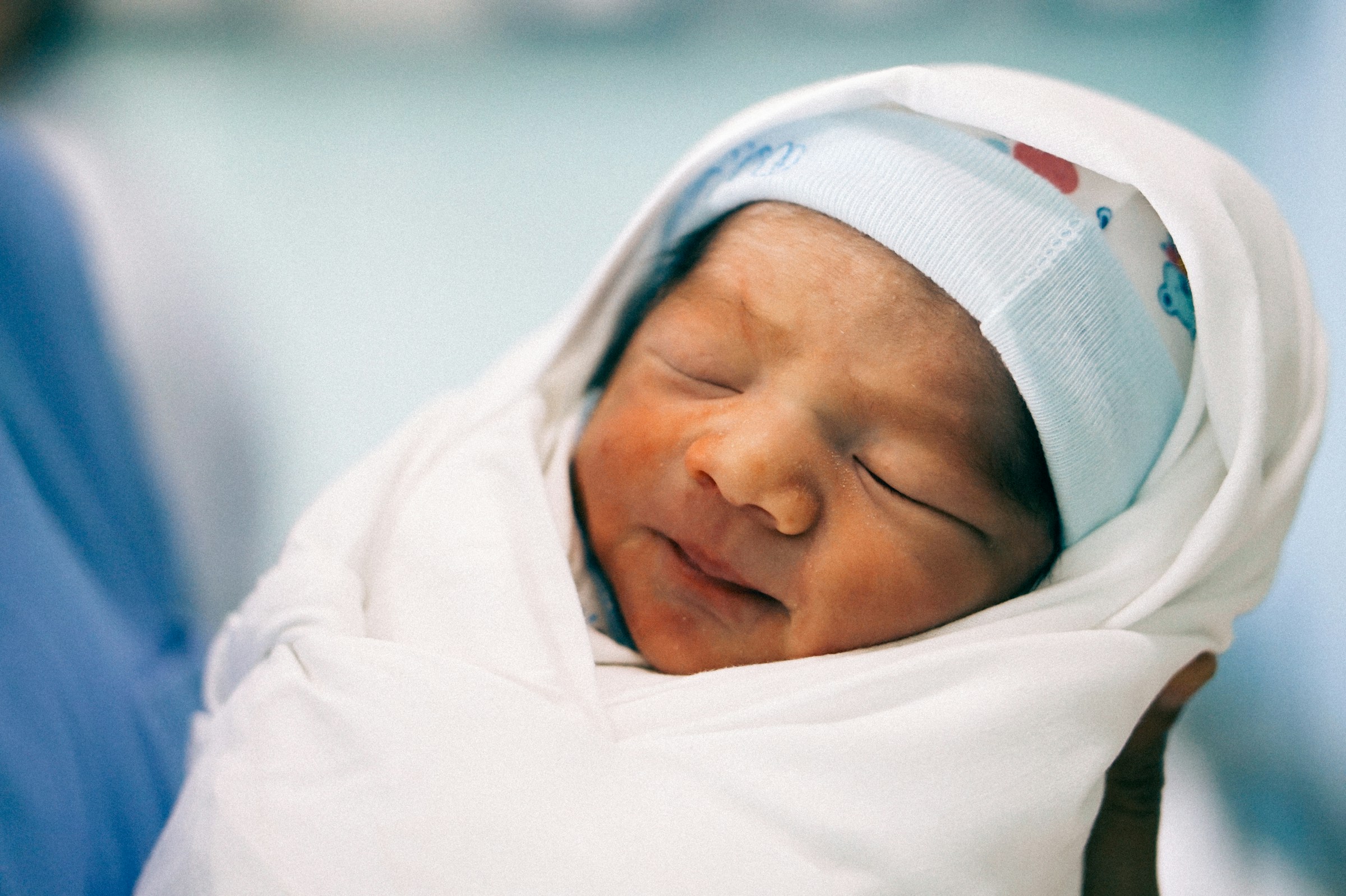Promo code
has been applied!
Promo code
has been applied!
Promo code
has been applied!
Newborn breathing issues and respiratory distress
Newborn breathing issues and respiratory distress
Sometimes newborns breathe faster or differently than usual. Learn about typical newborn breathing patterns, signs of respiratory distress, and what to do if you are worried about a breathing problem.
Sometimes newborns breathe faster or differently than usual. Learn about typical newborn breathing patterns, signs of respiratory distress, and what to do if you are worried about a breathing problem.

Megan N. Freeland, PharmD
Content Writer

Dr. Marcy Borieux
Pediatrician



Typical newborn breathing
A newborn’s breathing rate is usually between 40 and 60 breaths per minute while awake. This means every 60 seconds, a newborn breathes 40 to 60 times. By the time a baby is six months old, the typical breathing rate is between 25 and 40 breaths per minute.
Newborn breathing is not always consistent. Periodic breathing is normal for newborns. This happens when a baby breathes more quickly than usual for several seconds, then pauses for up to 10 seconds between breaths.
Newborn breathing may be inconsistent or irregular because:
Their lungs and the muscles that help them breathe are still developing.
Their lungs may contain fluid.
Their airways are smaller and more easily blocked than adults’.
They breathe mostly through their nostrils rather than their mouths.
Newborn breathing issues
Transient tachypnea
Transient tachypnea (pronounced “tuh-KIP-nee-uh”) is a breathing issue that mainly affects newborns during the first few hours to days of life. It means your newborn has a fast breathing rate but the condition doesn’t last long.
Per Stanford Medicine, signs of transient tachypnea include:
Infant breathing rate above 60 breaths per minute
Grunting noises while breathing
Flaring nostrils
Skin pulling in around the ribs while breathing
Meconium aspiration syndrome
Meconium is a baby’s first poop, and meconium aspiration happens when the baby inhales meconium and amniotic fluid during the birth process. Aspirating – or breathing in — meconium can result in symptoms like:
Breathing fast
Muscles pulling in around the ribs while breathing
Grunting noises while breathing
Bluish skin (A baby’s skin may also appear yellow if meconium has been present in the amniotic fluid for longer.)
Bloated chest
Respiratory distress syndrome
Respiratory distress describes any trouble breathing your baby might have. If your baby changes colors or appears to be struggling to breathe, they may be in respiratory distress, and you should get medical help immediately.
Respiratory distress syndrome (RDS) is a condition that happens when a newborn’s lungs don’t make enough of something called surfactant. Surfactant helps keep your baby’s lungs open fully so that they can breathe properly. It’s not until the third trimester that surfactant is made in the lungs, so RDS is common in babies born prematurely. Symptoms of RDS include:
Fast, shallow breathing
Grunting while breathing
Flaring nostrils
Bluish skin and lips
Muscles pulling in around the ribs while breathing
A doctor may run tests like chest X-rays, heart tests, or blood tests to determine whether your child has RDS or other types of breathing conditions that affect newborns.
Pneumonia
Pneumonia is a lung infection caused by bacteria, viruses, or fungi. In newborns, pneumonia can develop during the first week of life (early-onset pneumonia) or after the first week of life (late-onset pneumonia).
Early-onset pneumonia happens when the newborn is exposed to bacteria or viruses in the uterus or as they pass through the birth canal. Newborns with early-onset pneumonia may be lethargic and feed poorly but don’t usually show the typical lung-related pneumonia symptoms you might expect.
Late-onset pneumonia happens if your newborn is exposed to viruses or bacteria in their environment. For example, babies who are in the neonatal intensive care unit (NICU) and who need a breathing tube have a higher risk of developing pneumonia. Symptoms of late-onset pneumonia include thick, discolored mucus and breathing issues.
Bacterial pneumonia can be treated with antibiotics. In infants older than 30 days old and younger than two years old, pneumonia is most often caused by viruses. Antibiotics do not treat viral pneumonia because antibiotics only work against bacteria.
Newborn breathing during sleep
Babies typically breathe more slowly during sleep, between 30 and 40 breaths per minute. Like awake times, newborn breathing during sleep can be irregular and inconsistent. Periodic breathing also happens during sleep.
When to seek medical help
If you notice any of the following signs that could signal a serious breathing issue with your newborn, get medical help immediately:
Breathing faster than 60 breaths per minute
Breathing slower than 30 breaths per minute
Skin or lips changing colors, like blue or purple
Skin or muscles around the ribs pulling in while breathing
Baby is lethargic or irritable
Typical newborn breathing
A newborn’s breathing rate is usually between 40 and 60 breaths per minute while awake. This means every 60 seconds, a newborn breathes 40 to 60 times. By the time a baby is six months old, the typical breathing rate is between 25 and 40 breaths per minute.
Newborn breathing is not always consistent. Periodic breathing is normal for newborns. This happens when a baby breathes more quickly than usual for several seconds, then pauses for up to 10 seconds between breaths.
Newborn breathing may be inconsistent or irregular because:
Their lungs and the muscles that help them breathe are still developing.
Their lungs may contain fluid.
Their airways are smaller and more easily blocked than adults’.
They breathe mostly through their nostrils rather than their mouths.
Newborn breathing issues
Transient tachypnea
Transient tachypnea (pronounced “tuh-KIP-nee-uh”) is a breathing issue that mainly affects newborns during the first few hours to days of life. It means your newborn has a fast breathing rate but the condition doesn’t last long.
Per Stanford Medicine, signs of transient tachypnea include:
Infant breathing rate above 60 breaths per minute
Grunting noises while breathing
Flaring nostrils
Skin pulling in around the ribs while breathing
Meconium aspiration syndrome
Meconium is a baby’s first poop, and meconium aspiration happens when the baby inhales meconium and amniotic fluid during the birth process. Aspirating – or breathing in — meconium can result in symptoms like:
Breathing fast
Muscles pulling in around the ribs while breathing
Grunting noises while breathing
Bluish skin (A baby’s skin may also appear yellow if meconium has been present in the amniotic fluid for longer.)
Bloated chest
Respiratory distress syndrome
Respiratory distress describes any trouble breathing your baby might have. If your baby changes colors or appears to be struggling to breathe, they may be in respiratory distress, and you should get medical help immediately.
Respiratory distress syndrome (RDS) is a condition that happens when a newborn’s lungs don’t make enough of something called surfactant. Surfactant helps keep your baby’s lungs open fully so that they can breathe properly. It’s not until the third trimester that surfactant is made in the lungs, so RDS is common in babies born prematurely. Symptoms of RDS include:
Fast, shallow breathing
Grunting while breathing
Flaring nostrils
Bluish skin and lips
Muscles pulling in around the ribs while breathing
A doctor may run tests like chest X-rays, heart tests, or blood tests to determine whether your child has RDS or other types of breathing conditions that affect newborns.
Pneumonia
Pneumonia is a lung infection caused by bacteria, viruses, or fungi. In newborns, pneumonia can develop during the first week of life (early-onset pneumonia) or after the first week of life (late-onset pneumonia).
Early-onset pneumonia happens when the newborn is exposed to bacteria or viruses in the uterus or as they pass through the birth canal. Newborns with early-onset pneumonia may be lethargic and feed poorly but don’t usually show the typical lung-related pneumonia symptoms you might expect.
Late-onset pneumonia happens if your newborn is exposed to viruses or bacteria in their environment. For example, babies who are in the neonatal intensive care unit (NICU) and who need a breathing tube have a higher risk of developing pneumonia. Symptoms of late-onset pneumonia include thick, discolored mucus and breathing issues.
Bacterial pneumonia can be treated with antibiotics. In infants older than 30 days old and younger than two years old, pneumonia is most often caused by viruses. Antibiotics do not treat viral pneumonia because antibiotics only work against bacteria.
Newborn breathing during sleep
Babies typically breathe more slowly during sleep, between 30 and 40 breaths per minute. Like awake times, newborn breathing during sleep can be irregular and inconsistent. Periodic breathing also happens during sleep.
When to seek medical help
If you notice any of the following signs that could signal a serious breathing issue with your newborn, get medical help immediately:
Breathing faster than 60 breaths per minute
Breathing slower than 30 breaths per minute
Skin or lips changing colors, like blue or purple
Skin or muscles around the ribs pulling in while breathing
Baby is lethargic or irritable
References
References:
Stanford Medicine. Transient Tachypnea of the Newborn. https://www.stanfordchildrens.org/en/topic/default?id=transient-tachypnea-of-the-newborn-90-P02420
Stanford Medicine. Meconium Aspiration. https://www.stanfordchildrens.org/en/topic/default?id=meconium-aspiration-90-P02384
NIH NHLBI. Newborn Breathing Conditions: Respiratory Distress Syndrome (RDS). https://www.nhlbi.nih.gov/health/respiratory-distress-syndrome
Hooven, T. A., & Polin, R. A. (2017). Pneumonia. Seminars in fetal & neonatal medicine, 22(4), 206–213. https://doi.org/10.1016/j.siny.2017.03.002
Stanford Medicine. Breathing Problems. https://www.stanfordchildrens.org/en/topic/default?id=breathing-problems-90-P02666
References:
Stanford Medicine. Transient Tachypnea of the Newborn. https://www.stanfordchildrens.org/en/topic/default?id=transient-tachypnea-of-the-newborn-90-P02420
Stanford Medicine. Meconium Aspiration. https://www.stanfordchildrens.org/en/topic/default?id=meconium-aspiration-90-P02384
NIH NHLBI. Newborn Breathing Conditions: Respiratory Distress Syndrome (RDS). https://www.nhlbi.nih.gov/health/respiratory-distress-syndrome
Hooven, T. A., & Polin, R. A. (2017). Pneumonia. Seminars in fetal & neonatal medicine, 22(4), 206–213. https://doi.org/10.1016/j.siny.2017.03.002
Stanford Medicine. Breathing Problems. https://www.stanfordchildrens.org/en/topic/default?id=breathing-problems-90-P02666
References:
Stanford Medicine. Transient Tachypnea of the Newborn. https://www.stanfordchildrens.org/en/topic/default?id=transient-tachypnea-of-the-newborn-90-P02420
Stanford Medicine. Meconium Aspiration. https://www.stanfordchildrens.org/en/topic/default?id=meconium-aspiration-90-P02384
NIH NHLBI. Newborn Breathing Conditions: Respiratory Distress Syndrome (RDS). https://www.nhlbi.nih.gov/health/respiratory-distress-syndrome
Hooven, T. A., & Polin, R. A. (2017). Pneumonia. Seminars in fetal & neonatal medicine, 22(4), 206–213. https://doi.org/10.1016/j.siny.2017.03.002
Stanford Medicine. Breathing Problems. https://www.stanfordchildrens.org/en/topic/default?id=breathing-problems-90-P02666
Summer Health offers fast and reliable pediatric urgent care through online doctors, all via text. Whether you’re worried about your baby's fever, rashes, or other children's health concerns, we provide expert advice and support anytime, right from your phone.

Explore Summer Health
Our team of pediatricians are ready to answer the everyday questions you have about your child’s health.
*Requires Summer Health account, starting at $20/mo





